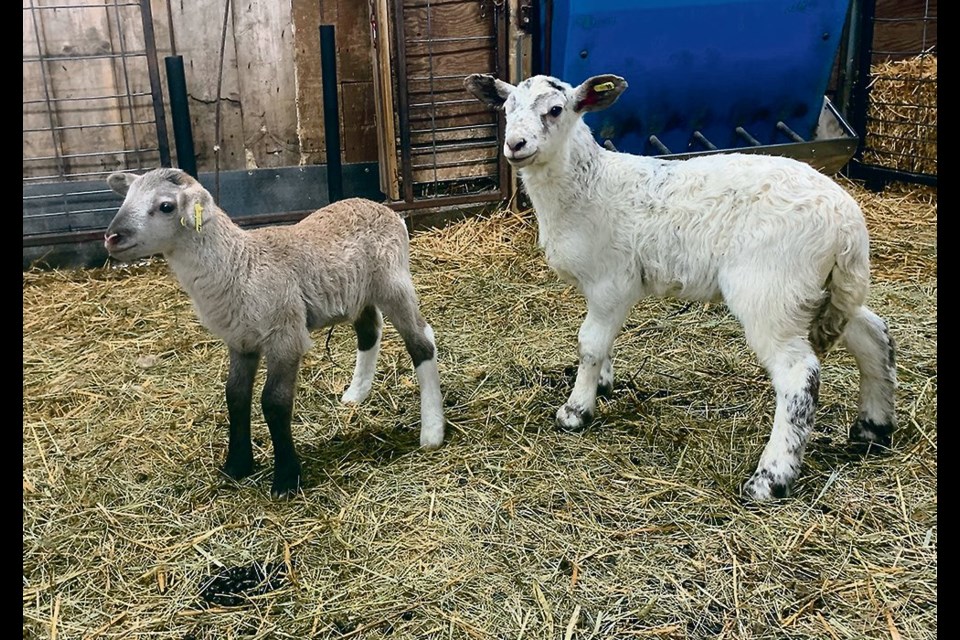ST. BRIEUX — The owners of Big Betty believe she is one of the world’s largest lambs.
Weighing 24.6 pounds at birth on April 11, she measured 16 inches tall and 42.5 inches long from front to back hoof.
“There’s a little monster we have out here,” said Bobbie Torrie, who owns Bochdacaty Farm with husband Chas near St. Brieux, Sask.
“Mama is doing OK but we are all in shock and awe.”
However, it was touch and go during the assisted natural birth, and it’s rare for a lamb this size to survive, she added.
It was also the first time the seven-year-old ewe had given birth to a single lamb. It usually has twins or triplets that average eight to 10 pounds each.
“She was about 10 days overdue, but I just figured triplets and took a little longer,” said Torrie.
As the ewe struggled to give birth, it was given two doses of oxytocin to ease the process.
“When the lamb started to come out it was upside down so we turned it and I was only able to get one foot out and realized this is a pretty big lamb when we saw the foot.
“After we got the head and foot out, the lamb was stuck and it was stuck hard. We were an hour and 26 minutes pulling it and the lamb lived.”
Much to Torrie’s surprise, the lamb and ewe survived the difficult experience with no injuries and both are thriving.
“I weighed her yesterday morning and thought my scale was off, so I reset it. I weighed her three times and was like, ‘oh my God.’
“She’s got three-inch-long hair and the chest cavity on her is about three times the size of a normal lamb. She’s huge. She’s off of a really big mom but she’s definitely a very big lamb,” said Torrie.
“This lamb is much bigger than anything else that we have. Our oldest lamb is just over two weeks old and it’s not even close to the same size.”
Single lambs tend to be larger, between 12 and 16 lb., she said.
“I think the heaviest single we’ve ever had here was 15 lb.”
The family has operated a commercial purebred Katahdin flock of sheep for the past 16 years. They typically birth about 100 lambs three times a year from about 50 ewes.
A lack of feed because of last summer’s drought forced them to change the feeding program, which consists mainly of straw with an added liquid supplement.
“Most of our lambs have been coming out in between that eight and 10 lb. Our heaviest this year was 12.1 lb., so we really haven’t had very many big lambs,” Torrie said.
“We haven’t been feeding grain so there was no rhyme or reason why this was such a big lamb.”
However, large single lambs have been fairly common this year, according to Gord Schroeder, executive director of the Saskatchewan Sheep Development Board.
“People have supplemented because of the feed and in situations where there was only one lamb, we’re seeing some huge lambs this year,” he said.
“If you’re feeding them for a triplet and they’re producing a single, you’re going to get big lambs. But that is a huge lamb,” he added about Big Betty.
“Normally if you’re going to have that kind of weight in lambs there’s going to be multiple births. But an older mature ewe definitely can give you a large lamb.”
Torrie and Schroeder are not sure where Big Betty ranks in the record books. Initial research suggests it may be the second largest surviving lamb in the world to be born.
“The first one I could find for an alive lamb was in the U.K. at 25 lb. and 15 inches high. I found another one from North Wales that was 24.2 lb. and 15 inches high,” Torrie said.
A week after giving birth, the ewe and her lamb were doing well.
“She’s up trying to jump and run around in her little pen and figuring out how her legs work. Mom is just hanging out in the barn, loving life right now, and getting the royal treatment. She loves that baby, loves it,” said Torrie.
Typically, lambs are up to normal butcher weight in four months, but Torrie doesn’t expect Big Betty will take that long.
However, the lamb may never travel that path.
“I’m pretty sure she’s going to stay here. It’s a once in a lifetime thing, so I don’t think I’ll sell her. We’ll keep her on the farm because I’m very curious to see what kind of lambs she’s going to produce.”

